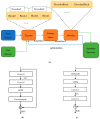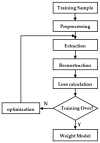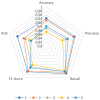ResNet-AE for Radar Signal Anomaly Detection
- PMID: 36016010
- PMCID: PMC9416614
- DOI: 10.3390/s22166249
ResNet-AE for Radar Signal Anomaly Detection
Abstract
Radar signal anomaly detection is an effective method to detect potential threat targets. Given the low Accuracy of the traditional AE model and the complex network of GAN, an anomaly detection method based on ResNet-AE is proposed. In this method, CNN is used to extract features and learn the potential distribution law of data. LSTM is used to discover the time dependence of data. ResNet is used to alleviate the problem of gradient loss and improve the efficiency of the deep network. Firstly, the signal subsequence is extracted according to the pulse's rising edge and falling edge. Then, the normal radar signal data are used for model training, and the mean square error distance is used to calculate the error between the reconstructed data and the original data. Finally, the adaptive threshold is used to determine the anomaly. Experimental results show that the recognition Accuracy of this method can reach more than 85%. Compared with AE, CNN-AE, LSTM-AE, LSTM-GAN, LSTM-based VAE-GAN, and other models, Accuracy is increased by more than 4%, and it is improved in Precision, Recall, F1-score, and AUC. Moreover, the model has a simple structure, strong stability, and certain universality. It has good performance under different SNRs.
Keywords: LSTM; anomaly detection; autoencoder; deep learning; residual networks.
Conflict of interest statement
The authors declare no conflict of interest.
Figures


















References
-
- Yang C.B. Research on Anomaly Detection Method of Electromagnetic Environment Based on Deep Learning. Harbin Engineering University; Harbin, China: 2020.
-
- Chandola V., Banerjee A., Kumar V. Anomaly Detection: A Survey. ACM Comput. Surv. 2009;41:1–58. doi: 10.1145/1541880.1541882. - DOI
-
- Hojjati H., Ho T., Armanfard N. Self-Supervised Anomaly Detection: A Survey and Outlook. arXiv. 20222205.05173 - PubMed
-
- Habeeb R.A.A., Nasaruddin F., Gani A., Hashem I.A.T., Ahmed E., Imran M. Real-time big data processing for anomaly detection: A Survey. Int. J. Inf. Manag. 2018;45:289–307. doi: 10.1016/j.ijinfomgt.2018.08.006. - DOI
-
- Ramaswamy S., Rastogi R., Shim K. Efficient Algorithms for Mining Outliers from Large Data Sets; Proceedings of the International Conference on Management of Data; Dallas, TX, USA. 15–18 May 2000; New York, NY, USA: ACM; 2000.
LinkOut - more resources
Full Text Sources
Other Literature Sources

